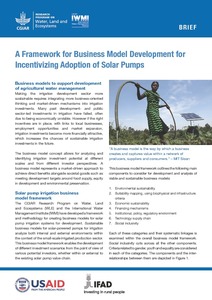Reviving Springs: An eight step methodology
Springs, also called dhara, mool, kuwa, naula, and chasma, are, the most important source of water for millions of people in the midhills of the Hindu Kush Himalayas. Spring water is used for drinking, irrigation, domestic, and religious purposes. They also perform important ecological functions, like supporting local vegetation and wildlife and maintaininng baseflow in rivers.
Unlocking the farming potential in Bangladesh’ polders.
The sustainable land management program in the Ethiopian highlands: An evaluation of its impact on crop production
Agricultural productivity in the highlands of Ethiopia is threatened by severe land degradation, resulting in significant reductions in agricultural GDP.
Synopsis: The Sustainable Land Management Program in the Ethiopian highlands: An evaluation of its impact on crop production
Agricultural productivity in Ethiopia’s highlands, the country’s breadbasket, is threatened by severe land degradation. To mitigate ongoing soil erosion and soil nutrient loss, the government of Ethiopia initiated the Sustainable Land Management Program (SLMP).
Mining water governance : everyday community-mine relationships in the Peruvian Andes
This thesis documents as well as questions how the presence of large mining operations in Andean regions of Peru alters social and natural landscapes. Taking conflicts over water as a useful entry-point for the analysis, it explores and unravels the dilemmas and challenges faced by the main conflicting actors: rural communities and mining companies.
Assessing land suitability for aquifer storage and recharge in northern Ghana using remote sensing and GIS multi-criteria decision analysis technique
Increasing climate variability and challenge in access to water pose major impediments to rainfed agricultural productivity. Extensive flooding of agricultural lands during the rainy season and lack of water during the 8-month long dry season affect the livelihood of the people in the northern Ghana, a situation that calls for better water management practices.
Agriculture in the Fertile Crescent: continuity and change under climate change.CAB Reviews
The Fertile Crescent (FC) is a high biodiversity region where most temperate-zone agricultural species originated and were first domesticated. A favourable environment, a special plant community and an adaptive population combined to initiate the transition from a hunter-gatherer economy to one based on agriculture and food production in the Fertile Crescent.
Runoff estimation and estimation of water balance components of Phetchaburi basin using soil and water assessment tool
Agro-climatic and hydrological characterization of selected watersheds in northern Ghana
A regional scale ecological risk framework for environmental flow evaluations
Recent developments in Environmental Flow (E-flow) frameworks advocate holistic, regional scale, probabilistic E-flow assessments that consider flow and non-flow drivers of change in socio-ecological context as best practice.








